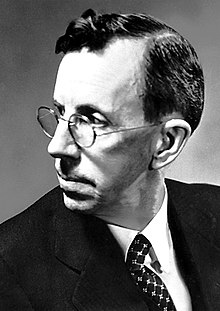Clinton Davisson
Appearance

Clinton Joseph Davisson (October 22, 1881 – February 1, 1958) was an American physicist who won the 1937 Nobel Prize in Physics for his discovery of electron diffraction in the famous Davisson–Germer experiment. Davisson shared the Nobel Prize with George Paget Thomson, who independently discovered electron diffraction at about the same time as Davisson.
| This article about a physicist is a stub. You can help out with Wikiquote by expanding it! |
Quotes
[edit]- Discoveries in physics are made when the time for making them is ripe, and not before.
- Davisson, Clinton (1937). "The Discovery of Electron Waves". Nobel Lectures, Physics 1922-1941. Amsterdam: Elsevier Publishing Company (1965).
- Of course, if electrons were waves there would be no difficulty. We think we understand the regular reflection of light and of x-rays--and we should understand the reflec- tion of electrons as well if electrons were only waves instead of particles. This observation though true does not seem a particularly valuable one. It is rather as if one were to see a rabbit climbing a tree, and were to say, "Well, that is rather a strange thing for a rabbit to be doing, but after all there is really nothing to get excited about. Cats climb trees --so that, if the rabbit were only a cat, we would understand its behavior perfectly." Of course, the explanation might be that what we took to be a rabbit was not a rabbit at all, but was actually a cat. Is it possible that we are mistaken about electrons? Is it possible that we have been wrong all this time in supposing that they are particles, and that actually they are waves? Well, 1 do not need to enumerate to you the many reasons we have for believing--I may say for knowing--that electrons are actually particles.
- Davisson, Clinton (May 1928). "Are Electrons Waves?". J. Franklin Institute 205 (5): 599. DOI:10.1016/S0016-0032(28)90979-5.


